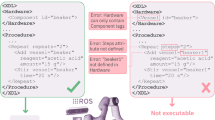Abstract
A knowledge-based software tool for developing interactive robot applications, called SPAK, has been developed. The “world” of interest is represented in a SPAK knowledge base by using a frame knowledge technique. This technique is chosen because it can represent the world meaningfully and naturally. Relationships among frames, which represent things in the world, and actions to be taken when certain things occur can be specified. In action, SPAK perceives changes in the environment, updates the knowledge base if needed, and generates output actions according to the knowledge contents. To support robotic applications, extensions to the conventional frame model are proposed. Various robotic applications can run cooperatively on top of SPAK. Each can easily make use of the knowledge available, and share its knowledge with others. A SPAK knowledge editor allows simple and intuitive development and modification of robot applications. To demonstrate these benefits, a prototype system and a sample robot application are developed. A multiagent technique is employed to combine various robotic components, both hardware and software, together. A sample dialogue manager for managing interactions with humans runs as an application on SPAK.
Similar content being viewed by others
References
Ueno H (2001) Symbiotic information systems: towards an ideal relationship of human beings and information systems. Technical Report of IEICE, KBSE2001, 15:27–34
Ishiguro H, Kanda T, Kimoto K, et al. (1999) A robot architecture based on situated modules. Proceedings of the IEEE/RSJ International Conference on Intelligent Robots and Systems, IEEE, pp 1617–1623
Lopes LS, Teixeira A (2000) Human–robot interaction through spoken language dialogue. Proceedings of the IEEE/RSJ International Conference on Intelligent Robots and Systems, (IROS-2000)
Sony Corporation, AIBO SDE, http://openr.aibo.com/ (2005) [Online]. Available: http://openr.aibo.com
Bruyninckx H (2005) The orocos project, http://www.orocos.org/ [Online]. Available: http://www.orocos.org/
DARPA Communicator Project, Galaxy Architecture Web Site, (2005) [Online]. Available: http://communicator.sf.net
Pellom B, Ward W, Hansen J, et al. (2001) University of Colorado dialog systems for travel and navigation. Proceedings of the Human Language Technology Conference (HLT-2001). Association for Computational Linguistics
S Larsson D Traum (2000) ArticleTitleInformation state and dialogue management in the trindi dialogue move engine toolkit Natural Language Eng 6 323–340 Occurrence Handle10.1017/S1351324900002539
V Ampornaramveth P Kiatisevi H Ueno (2004) ArticleTitleSPAK: software platform for agents and knowledge management in symbiotic robots IEICE Trans Inf Syst E87-D 886–895
Minsky M (1974) A framework for representing knowledge. MIT-AI Laboratory Memo 306
NF Noy MA Musen JLV Mejino SuffixJr et al. (2004) ArticleTitlePushing the envelope: challenges in a frame-based representation of human anatomy Data Knowledge Eng 48 335–359 Occurrence Handle10.1016/j.datak.2003.06.002
Ueno H, Saito Y (1996) Model-based vision and intelligent task scheduling for autonomous human-type robot arm. Robotics Auton Syst. Special Issue of Robotics and Autonomous Systems 195–206
Noy N, Fergerson R, Musen M (2000) The knowledge model of protege-2000: combining interoperability and flexibility. [Online] Available: citeseer.ist.psu.edu/noy01knowledge.html
UserLand Software (2005) XML-RPC. [Online] Available: http://www.xmlrpc.org/
Kiatisevi P, Ampornaramveth V, Ueno H (2004) A distributed architecture for knowledge-based interactive robots. Proceedings of the 2nd International Conference on Information Technology and Applications (ICITA 2004), Harbin, China. Macquarie Scientific Publishing
Kanda T, Ishiguro H, Ono T, et al. (2002) Development and evaluation of an interactive humanoid robot: Robovie. Proceedings of the IEEE International Conference on Robotics and Automation (ICRA 2002). IEEE
HA Rowley S Baluja T Kanade (1998) ArticleTitleNeural network-based face detection IEEE Trans Pattern Anal Machine Intel 20 23–38 Occurrence Handle10.1109/34.655647
Turk MA, Pentland AP (1991) Face recognition using eigenfaces. Proceedings of the 11th International Conference on Pattern Recognition. IEEE, pp 586–591
University of Edinburgh (2005) The Festival Speech Synthesis System. [Online] Available: http://www.cstr.ed.ac.uk/projects/festival/
MF McTear (2002) ArticleTitleSpoken dialogue technology: enabling the conversational user interface ACM Comput Surveys 34 90–169 Occurrence Handle10.1145/505282.505285
Hans M, Baum W (2001) Concept of a hybrid architecture for care-o-bot. Proceedings of ROMAN-2001. IEEE, pp 407–411
Bos J, Klein E, Oka T (2003) Meaningful conversation with a mobile robot. Proceedings of the 10th. Conference of the European Chapter of the Association for Computational Linguistics (EACL). Association for Computational Linguistics
Lauria S, Bugmann G, Kyriacou T, et al. (2002) Mobile robot programming using natural language. Robotics Auton Syst 38:171–181
Beingmeta (2005) Framerd. [Online] Available: http://www.framerd.org/
D Skuce TC Lethbridge (1995) ArticleTitleCODE4: a unified system for managing conceptual knowledge Int J Hum Comput Stud 42 413–451 Occurrence Handle10.1006/ijhc.1995.1019
Noy N, Fergerson R, Musen M (2000) The knowledge model of protege-2000: combining interoperability and flexibility. Proceeding of the 12th International Conference on Knowledge Engineering and Knowledge Management (EKAW). Springer
Hewett M (2005) Algernon – rule-based programming. http://algernon-j.sf.net/ [Online] Available: http://algernon-j.sourceforge.net/
Hasanuzzaman M, Zhang T, Ampornaramveth V et al. (2004) Gesture-based human–robot interaction using a frame-based software platform. Proceedings of the International Conference on Systems, Man and Cybernetics (IEEE SMC 2004). IEEE
Zhang T, Ampornaramveth V, Kiatisevi P et al. (2004) Knowledge-based multiple robots coordinative operation using software platform. Proceedings of the 6th Joint Conference on Knowledge-Based Software Engineering (JCKBSE 2004). IEICE
Soshnikov D (2002) An architecture of distributed frame hierarchy for knowledge sharing and reuse in computer networks. Proceedings of the 2002 IEEE International Conference on Artificial Intelligence Systems. IEEE, pp 115–119
National Institute of Informatics (NII), Japan (2005) SPAK [Online] Available: http://sis.ex.nii.ac.jp/spak/
Author information
Authors and Affiliations
Corresponding author
About this article
Cite this article
Kiatisevi, P., Ampornaramveth, V. & Ueno, H. A frame-based knowledge software tool for developing interactive robots. Artif Life Robotics 10, 18–28 (2006). https://doi.org/10.1007/s10015-005-0368-2
Received:
Accepted:
Issue Date:
DOI: https://doi.org/10.1007/s10015-005-0368-2



